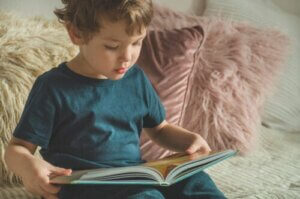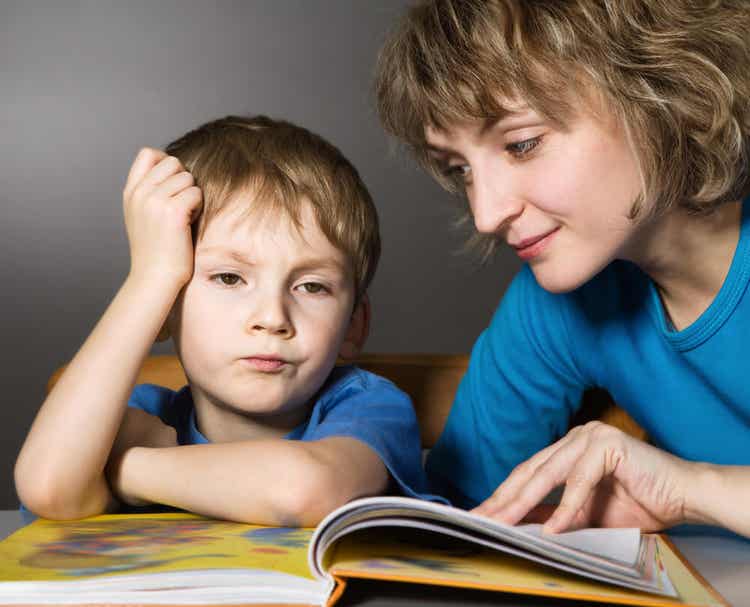How to Choose a Good Book for Your Children to Read


Written and verified by the psychologist Elena Sanz Martín
Reading opens the door to knowledge and fantasy and allows us to better understand the world. It transports us to other realities. The benefits for children and adults are innumerable. However, it’s common for many children to end up perceiving reading as an obligation they’d rather avoid. And this happens, in large part, because they haven’t learned how to choose a good book.
In many homes, there are constant conflicts due to children’s refusal of their parents’ request that they read regularly. How can you prevent this from happening? Have a flexible attitude that encourages children to read at their own pace instead of forcing them.
Setting an example as parents is also very important. But, above all, it’s essential that children have access to books that motivate them. So, we’ll bring you some useful recommendations regarding how to choose a good book for your little ones.
“If you don’t like to read, you haven’t found the right book.”
— J. K. Rowling—
How to choose a good book for your children to read

Define their tastes
First of all, to choose a good book for your child, think about their tastes and preferences. Some children enjoy visiting imaginary worlds in fantasy books. Others live thrilling adventures in fiction novels. But there are also children for whom curiosity takes precedence over imagination. And these children may marvel at reading a book about dinosaurs or the planets of the universe.
Perhaps what may seem boring to you is what most encourages your child to read. So, be sure to probe into their interests.
Offer options
At first, it may not be easy to define your child’s tastes. In fact, they may not be quite clear about them either. This is why it’s very positive to offer them access to a wide variety of alternatives.
A visit to the library can be the ideal time to explore and dive into books of different genres and formats in order to find the most appropriate one. Also, before buying a book, you can read the synopsis to get an idea of the material waiting inside.
If you have an e-book at home, you can even download free excerpts from many of the books to read them and see if they’re to your child’s liking before purchasing them.
Classic and familiar books
If you don’t know where to start, the classics can be a good choice. The Neverending Story, Charlotte’s Web, Gulliver’s Travels, and other similar stories have captivated several generations of children and can also capture the attention of yours.
In addition, you can try to remember what your favorite books were in your childhood and offer them to your little ones. The simple fact of knowing how much you liked them and how many hours you spent between their pages can produce curiosity for those books.
Reading as a social activity
It’s true that reading’s usually an individual activity, a moment of calm and disconnection to enjoy alone. But is there anything more rewarding than sharing your passion for a particular story with others? Is there anything more enjoyable than discussing the details, the progress of the narrative, or your impressions of how the story that’s so fascinated you will end?
For children to enjoy this social aspect, you can sign them up for a children’s book club, either in person or online. This regular meeting with other child readers will motivate your child to read at home and will make them feel part of a community with the same interests.

Even school friends or cousins of a similar age can become the best reading buddies. Asking these little ones what their literary preferences are or borrowing their favorite books and then discussing them is an interesting initiative. This exchange of books among children will also help to promote other values such as responsibility or the value of sharing.
Choose the right book to encourage reading in the youngest of children
Whatever book you choose to encourage your children to read, it’s important to make sure it’s suitable for their age. The size of the font, the amount of text, or the presence of illustrations are factors that change as the age of the children for whom the book is intended increases. However, if you choose appropriate options, you can start encouraging the habit of reading as early as your child’s first year.
Flicking through a picture book with parents or listening to a story read aloud before bedtime are simple actions that help build a child’s positive attitude toward reading. As the child gets older, they’ll be more likely to want to read on their own.
“The more that you read, the more things you will know. The more that you learn, the more places you’ll go.”
— Dr. Seuss—
Reading opens the door to knowledge and fantasy and allows us to better understand the world. It transports us to other realities. The benefits for children and adults are innumerable. However, it’s common for many children to end up perceiving reading as an obligation they’d rather avoid. And this happens, in large part, because they haven’t learned how to choose a good book.
In many homes, there are constant conflicts due to children’s refusal of their parents’ request that they read regularly. How can you prevent this from happening? Have a flexible attitude that encourages children to read at their own pace instead of forcing them.
Setting an example as parents is also very important. But, above all, it’s essential that children have access to books that motivate them. So, we’ll bring you some useful recommendations regarding how to choose a good book for your little ones.
“If you don’t like to read, you haven’t found the right book.”
— J. K. Rowling—
How to choose a good book for your children to read

Define their tastes
First of all, to choose a good book for your child, think about their tastes and preferences. Some children enjoy visiting imaginary worlds in fantasy books. Others live thrilling adventures in fiction novels. But there are also children for whom curiosity takes precedence over imagination. And these children may marvel at reading a book about dinosaurs or the planets of the universe.
Perhaps what may seem boring to you is what most encourages your child to read. So, be sure to probe into their interests.
Offer options
At first, it may not be easy to define your child’s tastes. In fact, they may not be quite clear about them either. This is why it’s very positive to offer them access to a wide variety of alternatives.
A visit to the library can be the ideal time to explore and dive into books of different genres and formats in order to find the most appropriate one. Also, before buying a book, you can read the synopsis to get an idea of the material waiting inside.
If you have an e-book at home, you can even download free excerpts from many of the books to read them and see if they’re to your child’s liking before purchasing them.
Classic and familiar books
If you don’t know where to start, the classics can be a good choice. The Neverending Story, Charlotte’s Web, Gulliver’s Travels, and other similar stories have captivated several generations of children and can also capture the attention of yours.
In addition, you can try to remember what your favorite books were in your childhood and offer them to your little ones. The simple fact of knowing how much you liked them and how many hours you spent between their pages can produce curiosity for those books.
Reading as a social activity
It’s true that reading’s usually an individual activity, a moment of calm and disconnection to enjoy alone. But is there anything more rewarding than sharing your passion for a particular story with others? Is there anything more enjoyable than discussing the details, the progress of the narrative, or your impressions of how the story that’s so fascinated you will end?
For children to enjoy this social aspect, you can sign them up for a children’s book club, either in person or online. This regular meeting with other child readers will motivate your child to read at home and will make them feel part of a community with the same interests.

Even school friends or cousins of a similar age can become the best reading buddies. Asking these little ones what their literary preferences are or borrowing their favorite books and then discussing them is an interesting initiative. This exchange of books among children will also help to promote other values such as responsibility or the value of sharing.
Choose the right book to encourage reading in the youngest of children
Whatever book you choose to encourage your children to read, it’s important to make sure it’s suitable for their age. The size of the font, the amount of text, or the presence of illustrations are factors that change as the age of the children for whom the book is intended increases. However, if you choose appropriate options, you can start encouraging the habit of reading as early as your child’s first year.
Flicking through a picture book with parents or listening to a story read aloud before bedtime are simple actions that help build a child’s positive attitude toward reading. As the child gets older, they’ll be more likely to want to read on their own.
“The more that you read, the more things you will know. The more that you learn, the more places you’ll go.”
— Dr. Seuss—
All cited sources were thoroughly reviewed by our team to ensure their quality, reliability, currency, and validity. The bibliography of this article was considered reliable and of academic or scientific accuracy.
- Aco Aco, L. (2016). ” Incentivar el gusto por la literatura en niños de educación primaria”: círculo de lectura para docentes. http://repositorio.iberopuebla.mx/bitstream/handle/20.500.11777/2001/Aco%20Aco%20Leandro.pdf?sequence=5&isAllowed=y
- Álvarez-Álvarez, C.; Pascual-Díaz, J. (2014). Aportaciones de un club de lectura escolar a la lectura por placer. El profesional de la información, 23 (6), 625-631. https://revista.profesionaldelainformacion.com/index.php/EPI/article/view/epi.2014.nov.10
- López, M. E. (2009). Qué y cómo leen los niños más pequeños? La construcción de espacios de lecturas compartidas 1. Recuperado de https://www.academia.edu/42750477/Qu%C3%A9_y_c%C3%B3mo_leen_los_ni%C3%B1os_m%C3%A1s_peque%C3%B1os_La_construcci%C3%B3n_de_espacios_de_lecturas_compartidas_1
- López Valero, A., Jerez Martínez, I., & Encabo Fernández, E. (2010). Aproximación a la poesía infantil. https://digitum.um.es/digitum/bitstream/10201/17374/1/Aproximaci%C3%B3n%20a%20la%20poes%C3%ADa%20infantil%20ALV.pdf
This text is provided for informational purposes only and does not replace consultation with a professional. If in doubt, consult your specialist.








